Citroen C1 RHD 2016 1.G Owners Manual
Manufacturer: CITROEN, Model Year: 2016, Model line: C1 RHD, Model: Citroen C1 RHD 2016 1.GPages: 268, PDF Size: 7.09 MB
Page 91 of 268
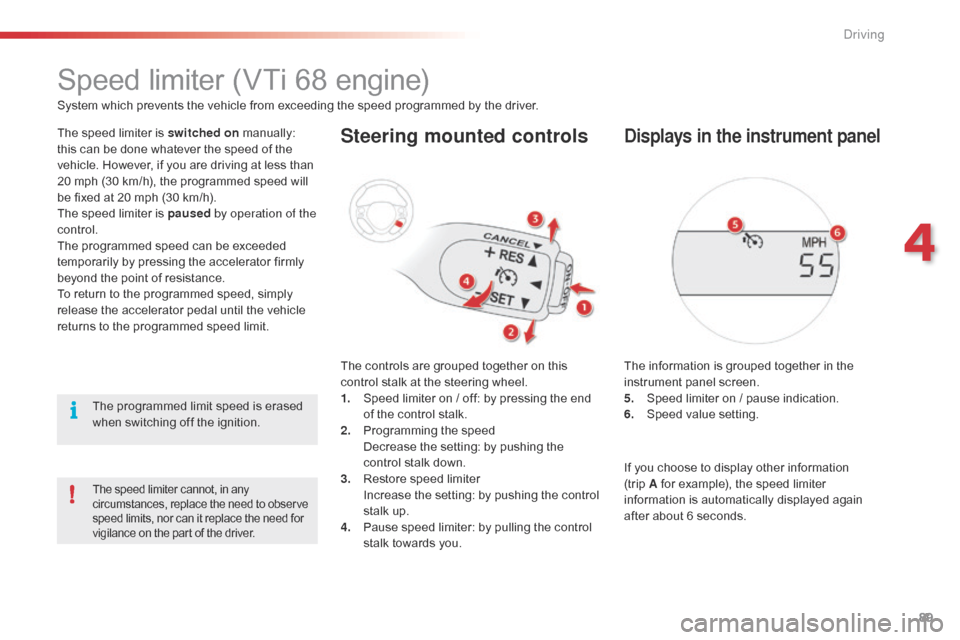
89
Speedô limiterô (VTiô 68ô engine)
Systemô whichô preventsô theô vehicleô fromô exceedingô theô speedô programmedô byô theô driver.
T he ô speed ô limiter ô is ô switched on
ô m
anually:
ô t
his ô can ô be ô done ô whatever ô the ô speed ô of ô the ô
v
ehicle. ô However, ô if ô you ô are ô driving ô at ô less ô than ô
2
0 ô mph ô (30 ô km/h), ô the ô programmed ô speed ô will ô
b
e ô fixed ô at ô 20 ô mph ô (30 ô km/h).
The
ô speed ô limiter ô is ô paused by operation of the
control.
The
ô programmed ô speed ô can ô be ô exceeded ô
t
emporarily ô by ô pressing ô the ô accelerator ô firmly ô
b
eyond ô the ô point ô of ô resistance.
To
ô return ô to ô the ô programmed ô speed, ô simply ô
r
elease ô the ô accelerator ô pedal ô until ô the ô vehicle ô
r
eturns ô to ô the ô programmed ô speed ô limit.
The
ô programmed ô limit ô speed ô is ô erased ô
w
hen ô switching ô off ô the ô ignition.
Steering mounted controls
Theô controlsô areô groupedô togetherô onô thisô control ô stalk ô at ô the ô steering ô wheel.
1.
ô S
peed ô limiter ô on ô / ô off: ô by ô pressing ô the ô end ô
o
f ô the ô control ô stalk.
2.
ô P
rogramming ô the ô speed
ô D
ecrease ô the ô setting: ô by ô pushing ô the ô
c
ontrol ô stalk ô down.
3.
ô R
estore ô speed ô limiter
ô I
ncrease ô the ô setting: ô by ô pushing ô the ô control ô
s
talk ô up.
4.
ô P
ause ô speed ô limiter: ô by ô pulling ô the ô control ô
s
talk ô towards ô you.
Displays in the instrument panel
Theô informationô isô groupedô togetherô inô theô instrument ô panel ô screen.
5.
ô S
peed ô limiter ô on ô / ô pause ô indication.
6.
ô S
peed ô value ô setting.
Theô speedô limiterô cannot,ô inô anyô circumstances, ô replace ô the ô need ô to ô observeô s
peed ô limits, ô nor ô can ô it ô replace ô the ô need ô for
ô v
igilance ô on ô the ô part ô of ô the ô driver.
Ifô youô chooseô toô displayô otherô informationô (tripô A
ô for ô example), ô the ô speed ô limiter ô
i
nformation ô is ô automatically ô displayed ô again ô
a
fter ô about ô 6 ô seconds.
4
Driving
Page 92 of 268
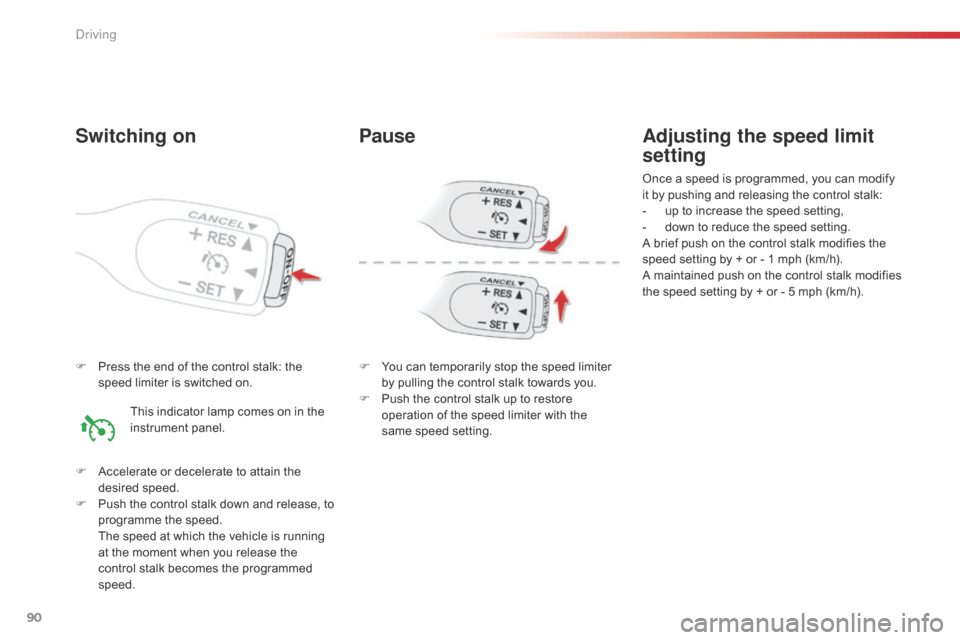
90
Fô Pressô the ô end ô of ô the ô control ô stalk: ô the ô s
peed ô limiter ô is ô switched ô on.
F
ô
A
ccelerate ô or ô decelerate ô to ô attain ô the ô
de
sired
ô s
peed.
F
ô
P
ush ô the ô control ô stalk ô down ô and ô release, ô to ô
p
rogramme ô the ô speed.
ô T
he ô speed ô at ô which ô the ô vehicle ô is ô running ô
a
t ô the ô moment ô when ô you ô release ô the ô
c
ontrol ô stalk ô becomes ô the ô programmed ô
s
peed.
Adjusting the speed limit
setting
Onceô aô speedô isô programmed,ô youô canô modifyô it ô by ô pushing ô and ô releasing ô the ô control ô stalk:
-
ô
u
p ô to ô increase ô the ô speed ô setting,
-
ô
d
own ô to ô reduce ô the ô speed ô setting.
A
ô brief ô push ô on ô the ô control ô stalk ô modifies ô the ô
s
peed ô setting ô by ô + ô or ô - ô 1 ô mph ô (km/h).
A
ô maintained ô push ô on ô the ô control ô stalk ô modifies ô
t
he ô speed ô setting ô by ô + ô or ô - ô 5 ô mph ô (km/h).
Switching on
Thisô indicatorô lampô comesô onô inô theô instrumentô pan el.
Pause
Fô Youô can ô temporarily ô stop ô the ô speed ô limiter ô b
y ô pulling ô the ô control ô stalk ô towards ô you.
F
ô
P
ush ô the ô control ô stalk ô up ô to ô restore ô
o
peration ô of ô the ô speed ô limiter ô with ô the ô
s
ame ô speed ô setting.
Driving
Page 93 of 268

91
Switching off
Fô Pressô the ô end ô of ô the ô control ô stalkô T
he ô display ô of ô information ô related ô to ô the ô
sp
eed
ô l
imiter
ô d
isappears.
Operating fault
Illuminationô ofô thisô warningô lampô inô the ô instrument ô panel ô indicates ô a ô fault ô
w
ith ô the ô speed ô limiter.
The
ô use ô of ô mats ô not ô approved ô by ô
C
ITROûN ô may ô inter fere ô with ô the ô
o
peration ô of ô the ô speed ô limiter.
To
ô
avoid ô any ô risk ô of ô jamming ô of ô the ô
ped
als:
-
ô
e
nsure ô that ô the ô mat ô is ô secured ô
c
o r r e c t l y,
-
ô
d
o ô not ô fit ô one ô mat ô on ô top ô of ô another.
Temporarily exceeding the
programmed speed
F Press f irmlyô on ô the ô accelerator ô pedal, ô g
oing ô beyond ô the ô point of resistance,
to
exceed
ô the ô programmed ô speed ô limit.
The
ô speed ô limiter ô is ô deactivated ô temporarily ô
a
nd ô the ô displayed ô programmed ô speed ô flashes.Have
ô it ô checked ô by ô a ô CITROûN ô dealer ô or ô a ô
q
ualified
ô w
orkshop.
An
ô audible ô signal ô accompanies ô the ô
f
lashing ô of ô the ô programmed ô speed ô
w
hen ô exceeding ô the ô speed ô is ô not ô due ô to ô
a
n ô action ô by ô the ô driver ô (steep ô hill...).
As
ô soon ô as ô the ô vehicle's ô speed ô returns ô to ô the ô
p
rogrammed ô value, ô the ô limiter ô operates ô again: ô
t
he ô display ô of ô the ô programmed ô speed ô becomes ô
s
teady ô again.
4
Driving
Page 94 of 268

92
Reversingô camera
Theô reversingô cameraô isô activatedô automaticallyô whenô reverseô gearô isô engaged.
T he ô reversing ô camera ô cannot ô in ô any ô
c
ircumstances ô replace ô the ô need ô for ô the ô
v
igilance ô on ô the ô part ô of ô the ô driver.The
ô image ô is ô provided ô in ô the ô touch ô screen ô
o
nly, ô with ô an ô indication ô of ô the ô limit ô of ô the ô rear ô
b
umpers ô (red ô line) ô and ô the ô general ô direction ô of ô
t
he ô vehicle ô (blue ô lines).Clean
ô the ô reversing ô camera ô regularly ô
u
sing ô a ô soft, ô dry ô cloth.
The
ô field ô of ô vision ô covered ô by ô the ô camera ô is ô
l
imited: ô objects ô in ô the ô immediate ô proximity ô of ô
t
he ô bumper ô or ô located ô below ô it ô are ô not ô visible.
The
ô camera's ô wide-angle ô lens ô deforms ô the ô
i
mage ô presented ô in ô the ô screen: ô the ô distances ô
v
isible ô in ô the ô screen ô may ô be ô different ô from ô
t
he ô true ô distances. ô This ô deformation ô varies ô
a
ccording ô to ô the ô loading ô of ô the ô vehicle ô and ô the ô
s
lope ô of ô the ô road.
High pressure jet washing
When
ô washing ô your ô vehicle, ô do ô not ô
d
irect ô the ô lance ô within ô 30 ô cm ô of ô the ô
c
amera ô lens.
Never
ô reverse ô the ô vehicle ô looking ô only ô
a
t ô the ô screen.
It
ô is ô normal ô to ô be ô able ô to ô see ô part ô of ô the ô number ô
p
late ô at ô the ô bottom ô of ô the ô screen.
Driving
Page 95 of 268

93
Laneô departureô warningô system
Systemô whichô detectsô theô unintendedô crossingô ofô longitudinalô trafficô laneô markingsô onô theô ground,ô usingô aô cameraô thatô recognisesô bothô solidô andô broken ô lines.
To
ô improve ô your ô safety, ô the ô camera ô analyses ô the ô image ô and ô then ô triggers ô a ô warning ô if ô the ô vehicle ô wanders ô over ô a ô lane ô marking ô (speed ô higher ô than ô
3
0ô mph ô (50 ô km/h)).
This
ô system ô is ô particularly ô suitable ô for ô motor ways ô and ô dual ô carriageways.
The
ô lane ô departure ô warning ô system ô
c
annot ô in ô any ô circumstances ô replace ô
t
he ô need ô for ô vigilance ô on ô the ô part ô of ô the ô
d
river.
It
ô is ô necessary ô to ô observe ô driving ô
r
egulations ô and ô take ô a ô break ô every ô
two
ô hours.
Activation
Fô Pressô this ô button, ô located ô on ô the ô steering ô w
heel.
Detection
Youô areô alertedô byô anô audibleô signalô andô theô display ô of ô a ô warning ô lamp ô in ô the ô instrument ô panel.
No
ô alert ô is ô given ô if ô the ô direction ô
i
ndicators ô are ô on ô and ô for ô around ô
20
ô seconds ô after ô they ô stop ô flashing.
The
ô
s
ystem
ô
s
hould
ô
b
e
ô
d
eactivated
ô
w
hen
ô
d
riving
ô
with
ô
snow
ô
chains
ô
or
ô
the
ô
spare
ô
w
heel
ô
fitted.
4
Driving
Page 96 of 268
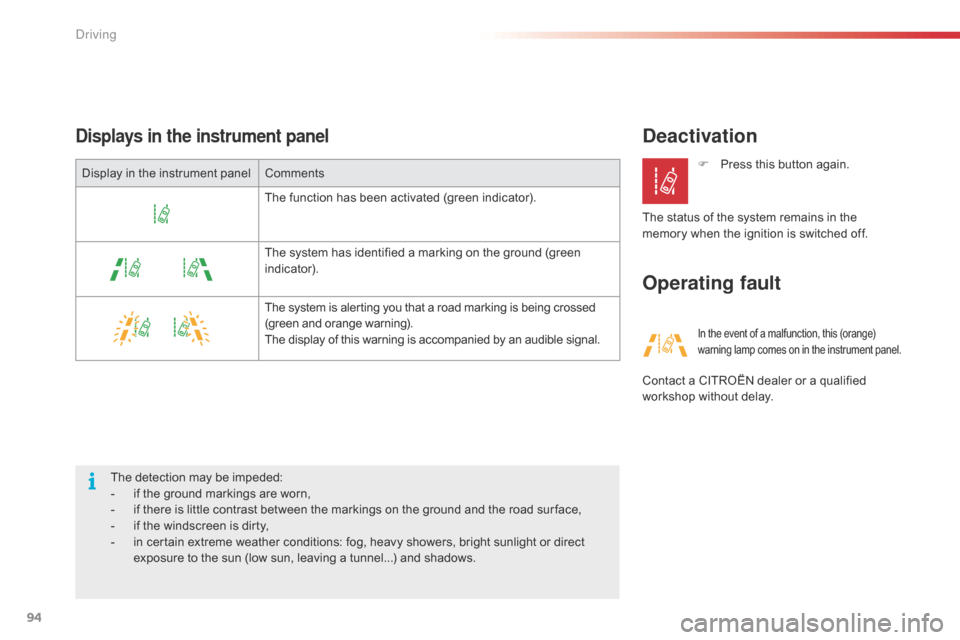
94
Deactivation
Operating faultDisplays in the instrument panel
Theô detectionô mayô beô impeded:
- ô i f ô the ô ground ô markings ô are ô worn,
-
ô
i
f ô there ô is ô little ô contrast ô between ô the ô markings ô on ô the ô ground ô and ô the ô road ô sur face,
-
ô
i
f ô the ô windscreen ô is ô dirty,
-
ô
i
n ô certain ô extreme ô weather ô conditions: ô fog, ô heavy ô showers, ô bright ô sunlight ô or ô direct ô
e
xposure ô to ô the ô sun ô (low ô sun, ô leaving ô a ô tunnel...) ô and ô shadows.F
ô
P
ress ô this ô button ô again.
The ô status ô of ô the ô system ô remains ô in ô the ô
m
emory ô when ô the ô ignition ô is ô switched ô off.
Inô theô eventô ofô aô malfunction,ô thisô (orange)ô w
arning ô lamp ô comes ô on ô in ô the ô instrument ô panel.
Contactô aô CITROûNô dealerô orô aô qualifiedô workshop ô without ô delay.
Display
ô
in
ô
the
ô
instrument
ô
panel
Comments
The
ô
function
ô
has
ô
been
ô
activated
ô
(green
ô
indicator).
The
ô
system
ô
has
ô
identified
ô
a
ô
marking
ô
on
ô
the
ô
ground
ô
(green
ô
i
ndicator).
The
ô
system
ô
is
ô
alerting
ô
you
ô
that
ô
a
ô
road
ô
marking
ô
is
ô
being
ô
crossed
ô (
green
ô
and
ô
orange
ô
warning).
The
ô
display
ô
of
ô
this
ô
warning
ô
is
ô
accompanied
ô
by
ô
an
ô
audible
ô
signal.
Driving
Page 97 of 268
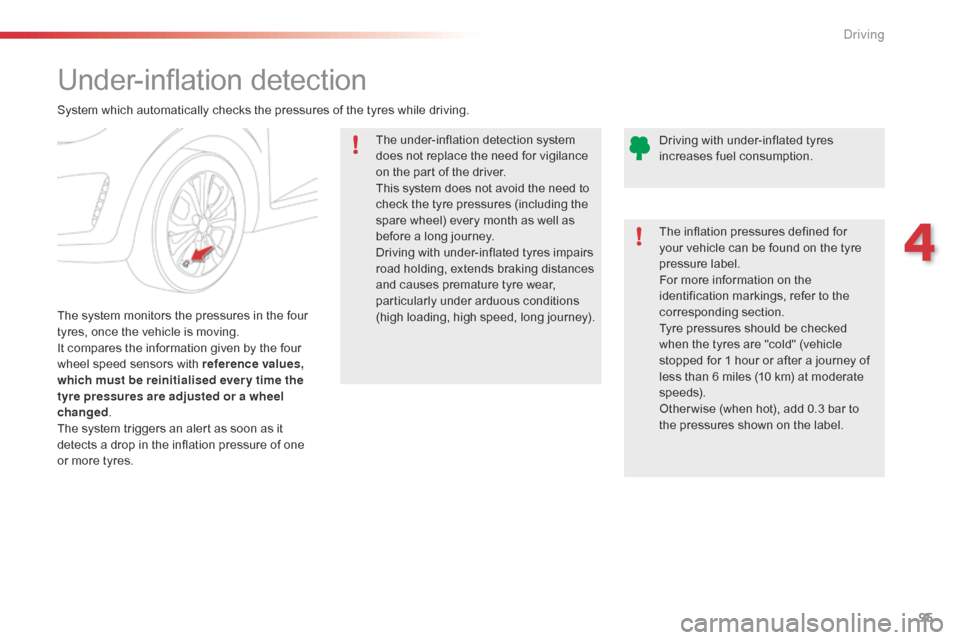
95
Under-inflationô detection
Theô systemô monitorsô theô pressuresô inô theô fourô t
yres, ô once ô the ô vehicle ô is ô moving.
It
ô compares ô the ô information ô given ô by ô the ô four ô
w
heel ô speed ô sensors ô with ô reference values,
which must be reinitialised ever y time the
tyre pressures are adjusted or a wheel
changed .
The
ô system ô triggers ô an ô alert ô as ô soon ô as ô it ô
d
etects ô a ô drop ô in ô the ô inflation ô pressure ô of ô one ô
o
r ô more ô tyres. The
ô under-inflation ô detection ô system ô
d
oes ô not ô replace ô the ô need ô for ô vigilance ô
o
n ô the ô part ô of ô the ô driver.
This ô system ô does ô not ô avoid ô the ô need ô to ô
c
heck ô the ô tyre ô pressures ô (including ô the ô
s
pare ô wheel) ô every ô month ô as ô well ô as ô
b
efore ô a ô long ô journey.
Driving ô with ô under-inflated ô tyres ô impairs ô
r
oad ô holding, ô extends ô braking ô distances ô
a
nd ô causes ô premature ô tyre ô wear, ô p
articularly ô under ô arduous ô conditions ô (
high ô loading, ô high ô speed, ô long ô journey).
System
ô which ô automatically ô checks ô the ô pressures ô of ô the ô tyres ô while ô driving.
The ô inflation ô pressures ô defined ô for ô
y
our ô vehicle ô can ô be ô found ô on ô the ô tyre ô
p
ressure ô label.
For ô more ô information ô on ô the ô
i
dentification ô markings, ô refer ô to ô the ô c
orrespondingô s ection.
Tyre ô pressures ô should ô be ô checked ô
w
hen ô the ô tyres ô are ô "cold" ô (vehicle ô
s
topped ô for ô 1 ô hour ô or ô after ô a ô journey ô of ô
l
ess ô than ô 6 ô miles ô (10 ô km) ô at ô moderate ô
s
peeds).
Other wise
ô (when ô hot), ô add ô 0.3 ô bar ô to ô
t
he ô pressures ô shown ô on ô the ô label.
Driving
ô with ô under-inflated ô tyres ô
i
ncreases ô fuel ô consumption.
4
Driving
Page 98 of 268
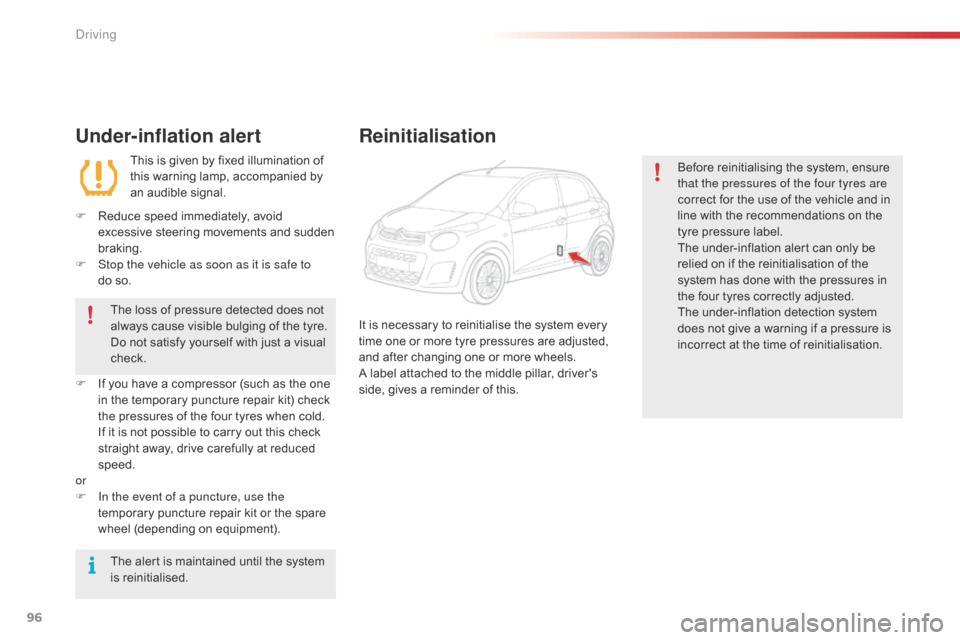
96
Under-inflation alert
Thisô isô givenô byô fixedô illuminationô ofô this ô warning ô lamp, ô accompanied ô by ô
a
n ô audible ô signal.
F
ô
R
educe ô speed ô immediately, ô avoid ô
e
xcessive ô steering ô movements ô and ô sudden ô
b
raking.
F
S
top the vehicle as soon as it is safe to
doô so.
The
ô loss ô of ô pressure ô detected ô does ô not ô
a
lways ô cause ô visible ô bulging ô of ô the ô tyre. ô
D
o
ô
not ô satisfy ô yourself ô with ô just ô a ô visual ô
c
heck.
F
ô
I
f
ô
you
ô have ô a ô compressor ô (such ô as ô the ô one ô
i
n
ô
the
ô temporary ô puncture ô repair ô kit) ô check ô
t
he
ô
pressures ô of ô the ô four ô tyres ô when ô cold.
ô I
f
ô
it
ô
is
ô not ô possible ô to ô carry ô out ô this ô check ô
s
traight ô away, ô drive ô carefully ô at ô reduced ô
s
peed.
or
F
I
n the event of a puncture, use the
temporary
ô puncture ô repair ô kit ô or ô the ô spare ô
w
heel ô (depending ô on ô equipment).
The
ô alert ô is ô maintained ô until ô the ô system ô
i
s
ô r
einitialised.
Reinitialisation
Beforeô reinitialisingô theô system,ô ensureô t hat the pressures of the four tyres are
correct
ô for ô the ô use ô of ô the ô vehicle ô and ô in ô
l
ine ô with ô the ô recommendations ô on ô the ô
t
yre ô pressure ô label.
The
ô under-inflation ô alert ô can ô only ô be ô
r
elied ô on ô if ô the ô reinitialisation ô of ô the ô
s
ystem ô has ô done ô with ô the ô pressures ô in ô
t
he ô four ô tyres ô correctly ô adjusted.
The
ô under-inflation ô detection ô system ô
d
oes ô not ô give ô a ô warning ô if ô a ô pressure ô is ô
i
ncorrect ô at ô the ô time ô of ô reinitialisation.
It
ô
is
ô
necessary
ô
to
ô
reinitialise
ô
the
ô
system
ô
every
ô
t
ime
ô
one
ô
or
ô
more
ô
tyre
ô
pressures
ô
are
ô
adjusted,
ô
a
nd
ô
after
ô
changing
ô
one
ô
or
ô
more
ô
wheels.
A
ô
label
ô
attached
ô
to
ô
the
ô
middle
ô
pillar,
ô
driver's
ô
s
ide,
ô
gives
ô
a
ô
reminder
ô
of
ô
this.
Driving
Page 99 of 268
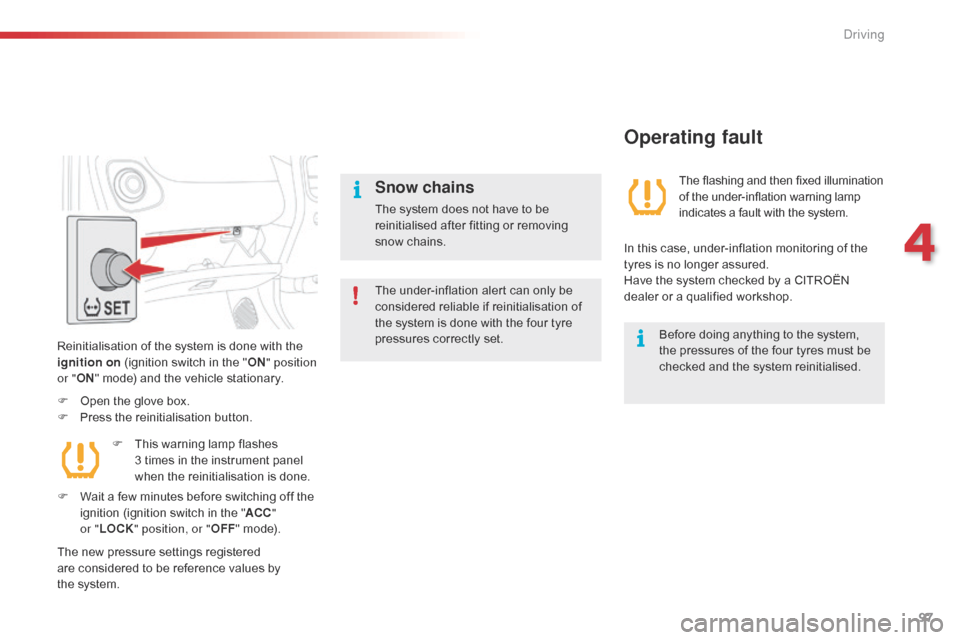
97
Theô under-inflationô alertô canô onlyô beô considered ô reliable ô if ô reinitialisation ô of ô
t
he ô system ô is ô done ô with ô the ô four ô tyre ô
p
ressures ô correctly ô set.
Snow chains
Theô systemô doesô notô haveô toô beô reinitialised ô after ô fitting ô or ô removing ô
sn
ow
ô c
hains.
Operating fault
Theô flashingô andô thenô fixedô illuminationô of ô the ô under-inflation ô warning ô lampô i
ndicates ô a ô fault ô with ô the ô system.
In
ô
this
ô
case, ô under-inflation ô monitoring ô of ô the ô
t
yres
ô
is
ô
no ô longer ô assured.
Have
ô
the
ô
system ô checked ô by ô a ô CITROûN ô
d
ealer
ô
or
ô
a ô qualified ô workshop.
Before
ô doing ô anything ô to ô the ô system, ô
t
he
ô pressures ô of ô the ô four ô tyres ô must ô be ô
c
hecked ô and ô the ô system ô reinitialised.
Reinitialisation
ô
of
ô
the
ô
system
ô
is
ô
done
ô
with
ô
the
ô
i
gnition on
ô
(ignition
ô
switch
ô
in
ô
the
ô
" ON " position
or " ON"
ô
mode)
ô
and
ô
the
ô
vehicle
ô
stationary.
F
ô
O
pen
ô
the
ô
glove
ô
box.
F
ô
P
ress
ô
the
ô
reinitialisation
ô
button.
The
ô
new
ô
pressure
ô
settings
ô
registered
ô
a
re
ô
considered
ô
to
ô
be
ô
reference
ô
values
ô
by
ô
t
heô system. F
ô
T
his
ô
warning
ô
lamp
ô
flashes
ô
3ô t
imes
ô
in
ô
the
ô
instrument
ô
panel
ô
w
hen
ô
the
ô
reinitialisation
ô
is
ô
done.
F
ô
W
ait
ô
a
ô
few
ô
minutes
ô
before
ô
switching
ô
off
ô
the
ô
i
gnition
ô
(ignition
ô
switch
ô
in
ô
the
ô
" ACC "
or " LOCK " position, or " OFF"
ô
mode).
4
Driving
Page 100 of 268

98
Exteriorô lightingô controlô stalk
Main lighting
Theô variousô frontô andô rearô lampsô ofô theô vehicleô are ô designed ô to ô adapt ô the ô driver's ô visibility ô
p
rogressively ô according ô to ô the ô ambient ô light ô
l
evel ô and ô weather:
-
ô
s
idelamps, ô to ô be ô seen,
-
ô
d
ipped ô beam ô headlamps ô to ô see ô without ô
d
azzling
ô o
ther
ô d
rivers,
-
ô
m
ain ô beam ô headlamps ô to ô see ô clearly ô when ô
t
he ô road ô is ô clear.
Additional lighting
Otherô lampsô areô providedô toô meetô theô requirements ô of ô particular ô driving ô conditions:
-
ô
a
ô rear ô foglamp,
-
ô
d
aytime ô running ô lamps ô to ô be ô more ô visible ô
d
uring ô the ô day. In
ô some ô weather ô conditions ô (e.g. ô low ô
t
emperature ô or ô humidity), ô the ô presence ô
o
f ô misting ô on ô the ô internal ô sur face ô of ô the ô
g
lass ô of ô the ô headlamps ô and ô rear ô lamps ô
i
s ô normal; ô it ô disappears ô after ô the ô lamps ô
h
ave ô been ô on ô for ô a ô few ô minutes.Travelling abroad
Ifô usingô yourô vehicleô inô aô countryô thatô d
rives ô on ô the ô other ô side ô of ô the ô road, ô the ô
h
eadlamps ô must ô be ô adjusted ô to ô avoid ô
d
azzling ô on-coming ô drivers.
Contact
ô a ô CITROûN ô dealer ô or ô a ô
q
ualified
ô w
orkshop.
Lighting and visibility